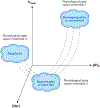Regulation of cell behavior and tissue patterning by bioelectrical signals: challenges and opportunities for biomedical engineering
- PMID: 22809139
- PMCID: PMC10472538
- DOI: 10.1146/annurev-bioeng-071811-150114
Regulation of cell behavior and tissue patterning by bioelectrical signals: challenges and opportunities for biomedical engineering
Abstract
Achieving control over cell behavior and pattern formation requires molecular-level understanding of regulatory mechanisms. Alongside transcriptional networks and biochemical gradients, there functions an important system of cellular communication and control: transmembrane voltage gradients (V(mem)). Bioelectrical signals encoded in spatiotemporal changes of V(mem) control cell proliferation, migration, and differentiation. Moreover, endogenous bioelectrical gradients serve as instructive cues mediating anatomical polarity and other organ-level aspects of morphogenesis. In the past decade, significant advances in molecular physiology have enabled the development of new genetic and biophysical tools for the investigation and functional manipulation of bioelectric cues. Recent data implicate V(mem) as a crucial epigenetic regulator of patterning events in embryogenesis, regeneration, and cancer. We review new conceptual and methodological developments in this fascinating field. Bioelectricity offers a novel way of quantitatively understanding regulation of growth and form in vivo, and it reveals tractable, powerful control points that will enable truly transformative applications in bioengineering, regenerative medicine, and synthetic biology.
Figures






References
-
- Robinson KR. 1989. Endogenous and applied electrical currents: their measurement and application. See Reference 26, pp. 1–25
-
- McCaig CD, Rajnicek AM, Song B, Zhao M. 2005. Controlling cell behavior electrically: current views and future potential. Physiol. Rev 85:943–78 - PubMed
-
- Fitzharris G, Baltz JM. 2006. Granulosa cells regulate intracellular pH of the murine growing oocyte via gap junctions: development of independent homeostasis during oocyte growth. Development 133:591–99 - PubMed
-
- Nuccitelli R 2003. A role for endogenous electric fields in wound healing. Curr. Top. Dev. Biol 58:1–26 - PubMed
Publication types
MeSH terms
Grants and funding
LinkOut - more resources
Full Text Sources
Other Literature Sources
Miscellaneous

